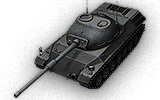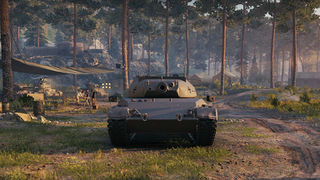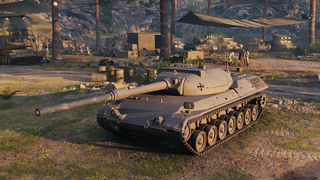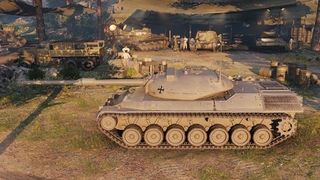какое оборудование ставить на леопард пта
Leopard prototyp A
Здравствуйте танкисты! Сегодня я продолжаю рассматривать новую ветку СТ германии. Сегодня на очереди машина до которой многие шли. Машина, которую многие ждали, хотели получить сразу. Машина, которая является прототипом главной СТ этого патча – Леопарда 1. Встречайте, Средний танк 9 уровня Leopard prototyp A:
Ну что же, машина 9 уровня способна показать зубы любому противнику. Цена данного желаемого аппарата составляет 3 450 000 кредитов и 172 800 опыта. Суммы уже значительные, даже за несколько дней более чем активной игры их не преодолеть.
Экипаж
Как и на предыдущей машине у нас 4 члена экипажа поэтому экипаж полностью подойдет. Поскольку машина 9 уровня и экипаж существенно влияет на ее характеристики, я рекомендую переобучить/обучить экипаж сразу до 100%. Сделать это можно 2 способами:
Так же я крайне рекомендую установить на машину камуфляж. Небольшой прирост % незаметности он даст. Тем более что в патче 0.8.5 его стоимость была значительно снижена. Стоить именно для этой машины он будет 90 000*3=270 000 кредитов.
Комплектация
Исследовать нужно много. Суммы уже достаточно большие и практически все нужно открывать с нуля. Однако все топовые модули будут последними. Вам больше не нужно будет исследовать двигатели, орудия и ходовые в этой ветке немецких СТ. Это ваш последний рубеж. Теперь разберем каждый модуль поподробнее:
Ну по традиции нам необходимо установить ходовую первой. Она добавит нам динамики. Сопротивление по различным грунтам, скорость поворота и прочность гусениц изменятся в лучшую сторону, но самым главным изменением является увеличения грузоподъемности. Это даст нам возможность установить новые более совершенные модули.
В отличии от предыдущей машины у нас есть прокачиваемая башня. Устанавливать новую башню необходимо в обязательном порядке. Она увеличит обзор, который для среднего танка очень важен, добавит немного прочности машине и позволит установить более совершенное орудие. Еще измениться бронирование, но это практически никак не повлияет на общую ситуацию. У нас достаточно большой картонный корпус чтобы нам стреляли в маленькую башню которая довольно часто рикошетит =)
Одно из самых значительных особенностей данной СТ – ее топовое орудие. Мы наносим огромный разовый урон, в среднем 390 единиц. Урон прекрасно сочетается с хорошей точностью и скорострельностью. Многие умные соперники будут избегать встречи с вашим орудием. Стоит по опыту оно достаточно много, но того стоит. Как я уже сказал выше, орудие относительно быстро сводится, перезаряжается и имеет более чем хорошую точность. Играя и ним грамотно можно наносить кучу урона за бой и, следовательно, получать много опыта и кредитов.
Скажу сразу что между стоковым и топовым двигателем огромное расстояние. Топовый двигатель добавляет нам примерно 200 л. с., но прибавка ощущается сразу. Для СТ это очень важно. Так же данный двигатель можно назвать уникальным т. к. шанс возгорания двигателя равен 10%. В игре до сих пор не было двигателей с таким низким процентом возгорания. Поэтому теоретически в патче 0.8.5, с введением «золотых» расходников за серебро, можно использовать вместо огнетушителя что то более полезное. Но о этом мы поговорим чуть ниже.
Нам дается достаточно хорошая топовая радиостанция. Дальности связи нам точно будет достаточно. Пренебрегать установкой более совершенной радиостанции нельзя, особенно СТ. Вы должны знать что происходит по всей карте, а не гадать на кофейной гуще …
В целом выделю такие достоинства и недостатки машины
Оптимальный вариант прокачки
Балансный вес
Как видно из таблицы мы попадаем на 9 – 11 уровни боев. Играть нам будет комфортно везде благодаря хорошим динамическим показателям и прекрасному орудию. Пробить мы можем всех, а стабильный нанесенный урон в больших количествах и является главным показателем хорошей игры.
Прибыльность
Не о каком фарме даже с ПА не может идти и речи. Можно стабильно играть в плюс, но все равно фармом этот плюс назвать нельзя. Естественно без ПА будут большие минуса и тут однозначно нужно будет играть на том, что приносит очень хороший доход. Если вы будите использовать золотые снаряды или расходники за серебро, то тут при хорошей игре с ПА не может быть и речи о игре даже в ноль.
Тактика
А вы играли на Т-54? Нет? Тогда учитесь! Ну вот собственно и все основы тактики =) Хоть мы и можем играть как на предыдущей машине в роль поддержки, не нужно так играть. За исключением когда против вас 4 СТ 10 уровня, тогда естественно в кучу лезть не нужно. Мы имеем скорость и прекрасное орудие, нам необходимо быстро занимать ключевые позиции на карте и благодаря своему урону обеспечивать преимущество. С нашей скоростью можно кружить ТТ, главное никогда не ездить одному. Брони у нас нет, поэтому стоять на месте нельзя. Любое попадание арты может быть очень болючим и последним. Я катая взводом из 3 леопардов, естественно не криворуких, получил кучу фана. Две – три таких машины при правильном применении способны вынести целое направление, главное действовать не так нагло как Т-54 в те времена, когда вся команда оставалась ловить 4 таракана на базе. А то они вырежут всю арту, 4 – 5 ТТ на базе и еще уедут =). Думайте что делаете и сильно не наглейте, тогда игра на этой машине будет результативной и принесет море фана.
Дополнительное оборудование
Последнее можно заменить на просветленку
Снаряжение
Теперь есть возможность покупать золотые расходники за серебро и появилось множество вариантов, я рекомендую вот такой:
Перки для экипажа
Поскольку мы уже практически дошли до леопарда 1, то мы будем ориентироваться на него, конечно не забывая и по текущую машину.
Leopard PT A [1.14.1]
Человек в высоком замке
Именно в это время, в 1956 году, в Западной Германии был поднят вопрос о разработке собственного танка, который мог бы составить конкуренцию бронетехнике государств Варшавского Договора. В 1957 году ФРГ и Франция заключили соглашение о совместном сотрудничестве, а в 1958 к ним присоединилась Италия. В то время германский Бундесвер имел на вооружении американские M47 и M48 «Паттон», оба с 90-мм орудиями, которые по плану должны были быть заменены более современными танками со 105-мм английской нарезной пушкой L7, обладавшей запредельными показателями бронепробития для того времени. При этом бронирование сознательно отодвигалось на задний план, в угоду максимальной мобильности и огневой мощи.
В Германии к разработке приступили три команды: А, В и С. Чуть позднее Франция вышла из совместного проекта из-за технических расхождений, в пользу разработки своего собственного танка AMX 30. Ожидалось, что либо новый западногерманский танк, либо AMX 30 станет единым боевым танком в обеих армиях, но в итоге каждый из них пошел своим путём. Проект команды C, от компании Carl F.W. Borgward, был отвергнут ввиду чрезвычайной сложности и экзотичности, прототип не был построен, а в 1961 году компания прекратила свое существование в связи с банкротством. Команда B, кооперация Ingenieurbüro Warneke, Rheinstahl-Hanomag, Henschel и Rheinmetall, представила то, что у нас в игре называется итальянским СТ IX уровня Standard B. Прототипы команды А, во главе с Porsche, проходили испытания в 1960-1963 годах, показали свое превосходство над французскими и американскими машинами и получили дальнейшее развитие, что в итоге привело к созданию танка Леопард 1.
Машина требует от своего владельца развитого навыка контролировать пространства вокруг себя, знания карт, снайперских позиций и зон поражения, времени подъезда противника в определенные места, умения быстро и вовремя отступать, умения маскироваться, а иногда даже светить. Новичкам вероятно трудно будет совладать с пятнистым зверем, потому рекомендую заранее набраться опыта в этом стиле игры. Леопард PT A ошибок не прощает, но и щедро вознаграждает своего владельца за мастерство.
Порядок прокачки, а также количество опыта и кредитов, необходимое для исследования:
Leopard Prototyp A
Leopard Prototyp A
3,450,000  Cost Cost |
| 1550 460 HP Hit Points |
| 39.17/39.5 20.55/42 t Weight Limit |
| 670 800 hp Engine Power |
| 65/20 km/h Speed Limit |
| 39 44 deg/s Traverse |
| 17.1 38.93 hp/t Power/Wt Ratio |
| Yes Yes Pivot |
Shell Cost
Reload Times
Nominal: 7 s
50% Crew: 8.67 s
75% Crew: 7.57 s
100% Crew: 6.71 s
Rammer: 6.04 s
Vents: 6.56 s
Both: 5.91 s
Both and BiA: 5.78 s
Both and Max Crew %: 5.54 s
See Crew, Consumables, or Equipment for more information.
Reload Times
Nominal: 10.6 s
50% Crew: 13.13 s
75% Crew: 11.47 s
100% Crew: 10.16 s
Rammer: 9.14 s
Vents: 9.94 s
Both: 8.94 s
Both and BiA: 8.75 s
Both and Max Crew %: 8.39 s
See Crew, Consumables, or Equipment for more information.
Using Shell Type 1 (250 Damage):
Theoretical Damage Per Minute
Nominal DPM: 2142.5
50% Crew: 1730
75% Crew: 1980
100% Crew: 2235
100% Crew
Vents: 2285
Rammer: 2482.5
Both: 2540
Both and BiA: 2595
Both and Max Crew %: 2707.5
Advantageous Damage Per Minute
First-shot DPM: 2392.5
50% Crew: 1980
75% Crew: 2230
100% Crew: 2485
100% Crew
Rammer: 2732.5
Vents: 2535
Both: 2790
Both and BiA: 2845
Both and Max Crew %: 2957.5
See here, here, or here for more information.
Using Shell Type 2 (250 Damage):
Theoretical Damage Per Minute
Nominal DPM: 2142.5
50% Crew: 1730
75% Crew: 1980
100% Crew: 2235
100% Crew
Vents: 2285
Rammer: 2482.5
Both: 2540
Both and BiA: 2595
Both and Max Crew %: 2707.5
Advantageous Damage Per Minute
First-shot DPM: 2392.5
50% Crew: 1980
75% Crew: 2230
100% Crew: 2485
100% Crew
Rammer: 2732.5
Vents: 2535
Both: 2790
Both and BiA: 2845
Both and Max Crew %: 2957.5
See here, here, or here for more information.
Using Shell Type 3 (330 Damage):
With wholly penetrating hits
Theoretical Damage Per Minute
Nominal DPM: 2828.1
50% Crew: 2283.6
75% Crew: 2613.6
100% Crew: 2950.2
100% Crew
Vents: 3016.2
Rammer: 3276.9
Both: 3352.8
Both and BiA: 3425.4
Both and Max Crew %: 3573.9
Advantageous Damage Per Minute
First-shot DPM: 3158.1
50% Crew: 2613.6
75% Crew: 2943.6
100% Crew: 3280.2
100% Crew
Rammer: 3606.9
Vents: 3346.2
Both: 3682.8
Both and BiA: 3755.4
Both and Max Crew %: 3903.9
See here, here, or here for more information.
Using Shell Type 1 (420 Damage):
Theoretical Damage Per Minute
Nominal DPM: 2377.2
50% Crew: 1919.4
75% Crew: 2196.6
100% Crew: 2478
100% Crew
Vents: 2532.6
Rammer: 2755.2
Both: 2814
Both and BiA: 2877
Both and Max Crew %: 3003
Advantageous Damage Per Minute
First-shot DPM: 2797.2
50% Crew: 2339.4
75% Crew: 2616.6
100% Crew: 2898
100% Crew
Rammer: 3175.2
Vents: 2952.6
Both: 3234
Both and BiA: 3297
Both and Max Crew %: 3423
See here, here, or here for more information.
Using Shell Type 2 (420 Damage):
Theoretical Damage Per Minute
Nominal DPM: 2377.2
50% Crew: 1919.4
75% Crew: 2196.6
100% Crew: 2478
100% Crew
Vents: 2532.6
Rammer: 2755.2
Both: 2814
Both and BiA: 2877
Both and Max Crew %: 3003
Advantageous Damage Per Minute
First-shot DPM: 2797.2
50% Crew: 2339.4
75% Crew: 2616.6
100% Crew: 2898
100% Crew
Rammer: 3175.2
Vents: 2952.6
Both: 3234
Both and BiA: 3297
Both and Max Crew %: 3423
See here, here, or here for more information.
Using Shell Type 3 (510 Damage):
With wholly penetrating hits
Theoretical Damage Per Minute
Nominal DPM: 2886.6
50% Crew: 2330.7
75% Crew: 2667.3
100% Crew: 3009
100% Crew
Vents: 3075.3
Rammer: 3345.6
Both: 3417
Both and BiA: 3493.5
Both and Max Crew %: 3646.5
Advantageous Damage Per Minute
First-shot DPM: 3396.6
50% Crew: 2840.7
75% Crew: 3177.3
100% Crew: 3519
100% Crew
Rammer: 3855.6
Vents: 3585.3
Both: 3927
Both and BiA: 4003.5
Both and Max Crew %: 4156.5
See here, here, or here for more information.
With 50% Crew: 0.421 m
With 75% Crew: 0.368 m
With 100% Crew: 0.326 m
With BiA: 0.319 m
With BiA and Vents: 0.312 m
Maximum possible: 0.299 m
For more details, see Crew
With 50% Crew: 0.384 m
With 75% Crew: 0.335 m
With 100% Crew: 0.297 m
With BiA: 0.291 m
With BiA and Vents: 0.284 m
Maximum possible: 0.273 m
For more details, see Crew
With 50% Crew: 3.097 s
With 75% Crew: 2.704 s
With 100% Crew: 2.397 s
With GLD: 2.179 s
With BiA: 2.344 s
With BiA and Vents: 2.293 s
With both and GLD: 2.085 s
Maximum possible: 1.998 s
For more details, see Crew or Equipment
With 50% Crew: 2.478 s
With 75% Crew: 2.163 s
With 100% Crew: 1.918 s
With GLD: 1.743 s
With BiA: 1.875 s
With BiA and Vents: 1.835 s
With both and GLD: 1.668 s
Maximum possible: 1.599 s
For more details, see Crew or Equipment
With 50% Crew: 306.4 m
With 75% Crew: 348.2 m
With 100% Crew: 390 m
With Recon and Situational Awareness: 409.7 m
With Coated Optics: 429 m
With Binocular Telescope: 487.5 m
Maximum possible: 558.3 m
For more details, see Skills or Equipment
With 50% Crew: 314.3 m
With 75% Crew: 357.2 m
With 100% Crew: 400 m
With Recon and Situational Awareness: 420.2 m
With Coated Optics: 440 m
With Binocular Telescope: 500 m
Maximum possible: 572.6 m
For more details, see Skills or Equipment
With 50% Crew: 565.7 m
With 75% Crew: 642.9 m
With 100% Crew: 720 m
With 100% Signal Boost: 864 m
When affected by 100% Relaying: 792 m
Maximum possible: 1036 m
For more details, see Skills or Equipment
With 50% Crew: 589.3 m
With 75% Crew: 669.7 m
With 100% Crew: 750 m
With 100% Signal Boost: 900 m
When affected by 100% Relaying: 825 m
Maximum possible: 1079.2 m
For more details, see Skills or Equipment
Additional Statistics
(Top Configuration)
Camouflage
Terrain Resistance
Dispersion Change Values
The Leopard Prototyp A is a German tier 9 medium tank.
Prototype developed from 1960 through 1961 as a medium tank for the Bundeswehr, with a total of 26 prototypes manufactured. The prototypes were tested up to 1963. The vehicle was the predecessor of the Leopard medium tank.
The Leopard Prototype is the pre-entry of the gameplay of the Leopard 1, featuring a much more mobile tank than its predecessor, the Indien-Panzer, with excellent accuracy, lower aiming time, a devastating gun, very good mobility, & acceleration.
The downside is the low rate of fire & extremely poor armor on all its angles; artillery will be the bane of this tank as HE shells can penetrate the frontal armor with devastating effects, so remaining mobile or hidden taking out enemies from a distance are viable options. At tier, only the French Bat.-Châtillon 25 t AP has lower armor.
The Leopard Prototyp A leads to the Leopard 1.
Modules / Available Equipment and Consumables
Modules
| Tier | Gun | Penetration (mm) | Damage (HP) | Rate of fire (rounds/minute) | Dispersion (m/100m) | Aiming time (s) | Weight (kg) | Price ( ) |
|---|
Engines
| Tier | Engine | Engine Power (hp) | Chance of Fire on Impact (%) | Weight (kg) | Price ( ) |
|---|
Suspensions
| Tier | Suspension | Load Limit (т) | Traverse Speed (gr/sec) | R min | Weight (kg) | Price ( ) |
|---|
Radios
Compatible Equipment






















Compatible Consumables
Player Opinion
Pros and Cons
Performance
The Leopard Prototyp A can fill two main roles to great effectiveness. One’s first thought when looking at the Leopard is the role of a sniper, & it is an excellent sniper indeed. Boasting a very accurate gun with 0.30 dispersion & a faster muzzle velocity than its predecessor. It combines high accuracy, good alpha damage, & fairly good DPM (
2800 with Rammer & Brothers in Arms) on a highly mobile, fairly well camouflaged tank. The Leopard can quickly position itself in advantageous sniping positions, positions which also often make great use of its high view range. All of this rolled into a single package makes it a threat from any distance, able to reliably hit weak points with its high penetration 105mm cannon, remain hidden while doing so, & re-position quickly to either get a new shot or retreat to a safe distance.
Leopard Prototyp A is stealthy vehicle, but this tank has no reliable armor at all. You have to use your speed to stay alive: A Leopard that draws half the enemy team’s attention is a dead Leopard. It is great at sniping at long range & is the perfect tank for vision control on open maps. If you have to fight close to other vehicles, never go without support & an escape route. The gun’s slow reload will force you to avoid any long-term combat & stick to the sniping role early on. Later in the game with support you can potentially go hunting for lone enemies, but do so with caution. It is not uncommon for the Leopard to be one-shot by tier 10 HESH rounds.
1-on-1 brawling with other mediums is to be avoided whenever possible. The low rate of fire & lack of armor means cover must be used as much as possible. Even then the duel will boil down to a contest of skill that will most likely still cost a significant amount of health even in case of victory.
Gun handling: from 0.15/0.15/0.10 (Fully upgraded) to 0.19/0.19/0.12 Stock and top tracks handling (0.17 and 0.15, respectively) to (0.21 and 0.19) Aim time for the 10.5cm on the top turret from 1.9 to 2
Early Research
Suggested Equipment


External Reviews and Opinions
Gallery
Historical Info
Development history
The Leopard project started in November 1956 in order to develop a modern tank, the Standard-Panzer, to replace the Bundeswehr’s American-built M47 & M48 Patton tanks, which, though just delivered to West Germany’s recently reconstituted army, were rapidly growing outdated. On 25 July 1957 the detailed specifications were released; the new design needed to weigh no more than thirty metric tons, have a power-to-weight ratio of thirty horsepower per ton, be able to withstand hits by 20 mm rapid-fire guns on every side as well as operate in a battlefield contaminated with chemical weapons or radioactive fallout, the then-standard baseline for combat with the Warsaw Pact. In addition, the main armament had to consist of a 105 mm caliber weapon (the new British L7A3 105 mm gun was selected), carrying at least as many rounds as current US tank designs. Mobility was the priority while firepower came second; armor was seen as less essential, as it was believed no real protection against hollow charge weapons was possible anyway.
France was very interested in the design as its own AMX 50 project had just failed. In June 1957, West Germany & the French Fourth Republic signed an agreement to develop a common tank, designated in German Europa-Panzer. Three German (Arbeit Gruppe A, B and C) & one French design team would be included in a competition, with each team producing two prototypes each. In September, 1958 Italy joined the development program. Several prototypes were entered for testing in 1960. Among the prototypes were Porsche’s Model 734 from team A, sporting a cast turret & that of team B (Rheinmetall) whose cast turret was somewhat higher. Team C from Borgward, designing a very futuristic tank, failed to have a prototype ready in time.
Even before these first prototypes were finished, it had (in 1959) been decided that a second phase with improved designs would be started: Team A had to build 26 phase II Prototypes for testing, team B six. Only two tanks of the required six would actually be constructed by team B. The Porsche Prototype II was eventually selected as the winner of the contest in 1963; this did not come as a surprise: it had already been decided in 1961 to build a pre series of fifty vehicles based on this design; production of these was started that very year. This «0-series» was modified with a new cast turret & several hull changes to raise the rear deck to provide more room in the engine compartment, & move some of the radiators to the upper sides of the hull. Before mass production of the standard version started it was decided to add an optical range-finding system for better long-range gunnery, which required the turret to be somewhat taller, & added «bumps» on either side of the turret to mount the optics for triangulation. In 1963 France & Germany had decided to each build their own tank; Germany continued with the Leopard, while France built the similar AMX-30. Production was set up at Krauss-Maffei of Munich from early 1964 onward, with deliveries of the first batch between September, 1965 & July, 1966. The Leopard was soon being purchased from Germany by a number of NATO members & other allies including in chronological order Belgium (1968), the Netherlands (1969), Norway (1970), Italy (1971), Denmark (1976), Australia (1976), Canada (1978), Turkey (1980) & Greece (1981). Germany has a strict export policy for military equipment; Greece, Spain & Chile, while still dictatorships, purchased the French AMX-30.
After the first batch was delivered the next three batches were the Leopard 1A1 model, which included a new gun stabilization system from Cadillac-Gage, allowing the tank to fire effectively on the move. The 1A1 also added the now-famous «skirts» along the sides to protect the upper tracks, & a new thermal jacket on the gun barrel to control heating. A less important change was to use rectangular rubber blocks fastened to the treads with a single pin instead of the earlier two-pin «shaped» versions. The rubber blocks could be easily replaced with metal X-shaped crampons for movement on ice & snow in the winter. Between 1974 and 1977 all of the machines in the first four batches were brought to the same Leopard 1A1A1 standard, & given additional turret armor developed by Blohm & Voss. A further upgrade in the 1980s added leftover image-intensifier night sights which were being handed down from the Leopard 2 as they were themselves upgraded. The PZB 200 image intensification system was mounted in a large box on the upper right of the gun, creating the Leopard 1A1A2. A further upgrade with SEM80/90 all-digital radios created the Leopard 1A1A3.
The first 232 tanks of the fifth production batch were delivered as the Leopard 1A2 between 1972 & 1974. The A2 included a heavier & better armored turret, & therefore did not receive the B&V armor add-ons as did the earlier machines. They did receive the other upgrades however; the Leopard 1A2A1 received the PZB 200, the Leopard 1A2A2 received digital radios, & the Leopard 1A2A3 got both.
The next 110 vehicles in the fifth batch were fitted with a new welded turret, which was equipped with a new armor consisting of two spaced steel plates with a plastic filling between them, & a wedge-shaped gun mantlet, creating the Leopard 1A3. Although the level of armor area density was equivalent to the A2’s new welded version, the internal volume was increased by 1.2 m³ & the effective protection level was increased by half. The improved TRP 2A independent sight was installed for the commander. Upgrades were identical to the 1A2 models, the Leopard 1A3A1 with the night sights, Leopard 1A3A2 with the new radios, & the Leopard 1A3A3 with both.
The Leopard 1A4 formed the sixth batch of 250 vehicles, delivery starting in 1974. The 1A4 was externally similar to the 1A3, but included a new computerized fire control system & the new EMES 12A1 sighting system to aim it. In addition, the commander was provided with his own independent night sighting system, the PERI R12. The new equipment used up space & the ammunition load were reduced to 55 rounds, of which 42 were stored in the magazine to the left of the driver.
In 1980 a research program was undertaken to study further improvements to the Leopard 1, providing it with a completely modern fire control system & fully effective night/bad-weather vision system. This was going to require even more room than the larger turret from the 1A3/1A4 models, so the decision was made to base the upgrades on the earlier models which were no longer competitive. The resulting Leopard 1A5 was based on 1225 vehicles of the Leopard 1A1A1 model. The turrets were again modified for the 1A5, with a larger section at the back, both in order to store all of the new equipment, as well as to move more of the ammunition into the rear turret, as opposed to the left side of the driver where it had traditionally been stored. The storage locker extended the turret almost to the rear of the tank when the gun was facing forward. The new turret was also able to mount the newer 120 mm gun from the Leopard 2 if desired, although this option has not been used. After trials the Krupp-Atlas Elektronik EMES 18 fire control system was selected in December 1983, developed from the EMES 15 used on the Leopard 2. The EMES 18 included two new sights on to the top of the turret, & no longer required the «bumps» as did the earlier optical systems. A crucial part of the upgrade was the introduction of more effective ammunition, including new APFSDS rounds. The Leopard tank could also be fitted with bolt-on Lexan armor panels, which have increased the effectiveness of the armor. These «modified» tanks have proved themselves in the field. The first modified vehicle was delivered in early 1987. Since then, almost all users of the Leopard 1 have also applied similar changes to their own vehicles, & in most ways the 1A5 can be considered the «standard» Leopard 1 today.
A single 1A1A1 was also modified with additional armor on the turret and had the 120 mm gun as the Leopard 1A6. The project was ended in 1987, as the Leopard 2 was in widespread service at this point and the 1A5 offered a reasonable upgrade path for a fraction of the cost.
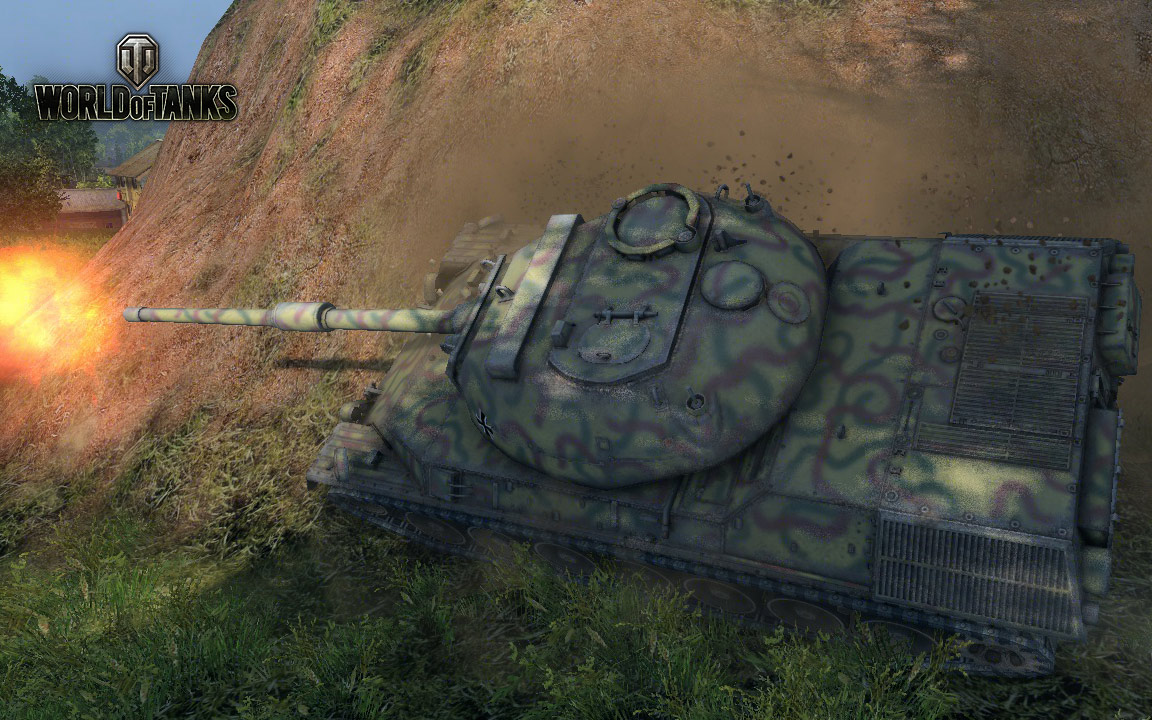
.PNG)
.png)
.png)
.png)
.png)
.png)



